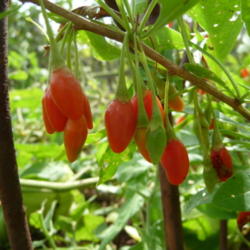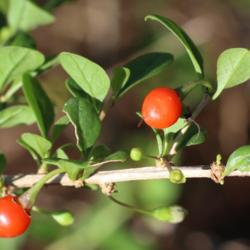I've been growing Gojiberries for several years now and have been so successful, I wanted to share this plant with everyone. If you've never grown this useful shrub, this article will motivate you to make it happen.
So far this year you've read my articles about many of my favorite plants, including luffas, malabar spinach, chickweed, lambsquarters, sunroots, tomatoes, yarrow, and comfrey. I chose to write about
Goji Berry (Lycium barbarum) this month because of its extremely easy to grow nature, and its health benefits. While most people call the plant Gojiberry, others call it Wolfberry. I like the latter name because it sounds more exotic.
I first heard of gojiberries when I was researching plants to grow near walnuts. Walnuts, as you may know, contain a powerful herbicide called juglone, which prevents competing plants from growing nearby. This is why walnut trees usually have dry shade under them where nothing will grow. Members of the nightshade family (which includes
tomatoes,
peppers,
eggplants, and
potatoes and, yes, gojiberry) are particularly susceptible to damage from juglone.
Well, my research revealed that by making (or finding) a
community guild of walnuts with hackberries, these two trees cancel out each others' allelopathic compounds. The implication was clear: I could grow anything I wanted as long as I had hackberries growing next to my walnuts. As luck would have it, I already had hackberries growing around my walnuts, so all I had to do was decide what to grow.
My reading suggested that in order to make this guild really impressive, you should plant nightshade families nearby. If they thrive, then you know you've got it made. But I didn't want to grow annuals down in my bottomland. I needed a perennial shrub that I could plant once, maybe water once, and then completely forget about until it was time to harvest. Gojiberry fit that bill perfectly.
Native to China, the gojiberry is a deciduous perennial shrub that grows to about 6 feet tall and 8 feet wide. It tends to make long canes similar to many blackberry species. The canes spread out from the central plant, and where they touch the ground, they root themselves. In this way, a gojiberry can spread out from where you plant it, but it's easy to control by simply mowing around it. It is the easiest-to-root shrub I've ever grown. Every cutting you take and stick in moist medium is guaranteed to root and thrive. I've grown many hundreds of gojiberries and have never had a cutting fail to root. I even had a cutting that I took once and forgot to stick in the medium for 2 days. When I remembered, I stuck it in the medium and sure enough, it quickly rooted and grew.
Gojiberry shows a lot of promise for xeriscapic landscapes. Once it is established it can survive and even thrive with no water in poorly-drained, nutrient-deficient soil. I have a steep hillside with bare red dirt that barely even grows weeds, so I planted gojiberries there and they have thrived and produced fruit.
In China these are called "red diamonds" and they've been cultivating them for human use for over 700 years. In 2013, over 50,000 tons of gojiberry fruits were harvested in China. It can take a year (or even two) before it bears fruit. As the growing season gets on, the plant grows quickly and then produces tiny purple flowers which give way to brilliant red fruits, the size of a raisin. Once the fruit is red you can pick them and use them. They can be eaten raw, but it seems most people dry them in the sun or dehydrator and then store them for later use. My favorite method of preparation is to take the dried fruits and add them to my teas while they are being steeped. I leave them in the tea and eat them while sipping the drink.
The young leaves can also be eaten as a leaf vegetable, best when cooked first. There are a number of chinese soup recipes that utilize these leaves, and they can be quite delicious. They can be used anywhere you would use spinach. The leaves are said to "clear heat" from the body, whatever that means, and have a strengthening effect on the lungs, kidneys and liver. A simple recipe might include chicken or beef stock, gojiberry leaves, some diced pork, salt and pepper. Add malabar spinach leaves to thicken to the desired consistency.
The main species plant,
Goji Berry (Lycium barbarum) , is readily available around East Texas. I have personally sold over 250 of these to gardeners within a hundred-mile radius of Jacksonville, TX, and I expect eventually everyone in Texas will be growing it. There are also improved cultivars that you can order online.
Goji Berry (Lycium barbarum Sweet Lifeberry®) and
Goji Berry (Lycium barbarum Big Lifeberry®) are the two cultivars that I'm trialing right now. They seem to produce bigger and more abundant fruit than the species.
Goji Berry (Lycium barbarum 'Crimson Star') is another cultivar that produces the same good fruit but on smaller dwarf plants.

